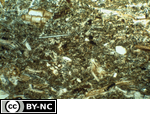Download Image
5.28 MB

ID # 180
Diatoms and organic materials in peatFrom the Soil Micromorphology Slide Collection
STEM Standard addressed: ESS2E - Biogeology
Appropriate Grade Level(s)
- College-level
- Classroom Lectures
- Laboratory Activities
- Soil Microbiology
Data for the horizon
Horizon sampled: 2C3 (llOc03)
Depth sampled: 867-882 cm
Physical and chemical data available: 2C3 (llOc03) (613-1094 cn): pH = 5.9, C = 17.4%, N =1 .2%, ash = 67.8%
Macromorphological description of horizon: 10 YR 4/2 sedimentary peat; massive.
Micromorphological description Of horizon: The soil fabric is dense with a tendency towards horizontal alignment of the following basic components: Very frequent diatoms (1 2.3%), dominantly Melosira sp.; occasional sponge spicules; abundant amorphous fine material (52.4%); frequent moderately to well decomposed organic particles (10100 that often have cell structures separating to form part of the fine material, mineral grains (2.1 %), and void space (8.2%). Rare plant tissues contain pyrite nodules. Percentage areal distributions were assessed from thin section by point counting approximately 3000 points on the thin section at 1 25x magnification.
Data for thin section
Preparation of sample: Acetone
Impregnating medium: Polyester resin
Thickness of section: 30 µm approximately
Orientation of section: Vertical
Soil Classification
U.S.: Entisol
F.A.O.: Gleysol
Canada: Limno Humisol
Elevation: 95 m above sea level
Physiographic position: Basin swamp.
Topography and hill slope position: Level
Parent material: Peat material (woody-sedge sedimentary, sedge-sedimentary and sedimentary)
Soil climatic data and/or soil water balance: Mesic mild humid (Soil Climates of Canada map (1 975))
Vegetation: Dominant vegetation in basin swamp is Spiarea douqlasii (80% cover) and Salix sp. (10% cover)
Horizon sampled: 2C3 (llOc03)
Depth sampled: 867-882 cm
Physical and chemical data available: 2C3 (llOc03) (613-1094 cn): pH = 5.9, C = 17.4%, N =1 .2%, ash = 67.8%
Macromorphological description of horizon: 10 YR 4/2 sedimentary peat; massive.
Micromorphological description Of horizon: The soil fabric is dense with a tendency towards horizontal alignment of the following basic components: Very frequent diatoms (1 2.3%), dominantly Melosira sp.; occasional sponge spicules; abundant amorphous fine material (52.4%); frequent moderately to well decomposed organic particles (10100 that often have cell structures separating to form part of the fine material, mineral grains (2.1 %), and void space (8.2%). Rare plant tissues contain pyrite nodules. Percentage areal distributions were assessed from thin section by point counting approximately 3000 points on the thin section at 1 25x magnification.
Data for thin section
Preparation of sample: Acetone
Impregnating medium: Polyester resin
Thickness of section: 30 µm approximately
Orientation of section: Vertical
Soil Classification
U.S.: Entisol
F.A.O.: Gleysol
Canada: Limno Humisol
Elevation: 95 m above sea level
Physiographic position: Basin swamp.
Topography and hill slope position: Level
Parent material: Peat material (woody-sedge sedimentary, sedge-sedimentary and sedimentary)
Soil climatic data and/or soil water balance: Mesic mild humid (Soil Climates of Canada map (1 975))
Vegetation: Dominant vegetation in basin swamp is Spiarea douqlasii (80% cover) and Salix sp. (10% cover)
Method
Data for 35-mm slide
Frame length: 1 .0 mm
Light mode: Plane polarized
Frame length: 1 .0 mm
Light mode: Plane polarized
References
Fox, C. A. and C. Tarnocai. 1989. The micromorphology of a sedimentary peat deposit from the Pacific temperate wetland region of Canada. p. 31 1-319. In L. A Douglas (ed.). Soil micromorphology: A basic and applied science. Proc. 8th IWMSM. Elsevier, New York.
Tarnocai, C. and Schuppli, P. 1987. Sedimentary peat in Canadian peatlands. p. 25-37. In C. D. A. Rubec and R.P. Overend (eds.) Proc. Symposium '87 Wetlands/Peatlands. Edmonton, Canada.
Slide BF36. Soil Science Society of America, 1993. A Reference Slide Collection for Soil Micromorphology. SSSA, Madison, WI.
Tarnocai, C. and Schuppli, P. 1987. Sedimentary peat in Canadian peatlands. p. 25-37. In C. D. A. Rubec and R.P. Overend (eds.) Proc. Symposium '87 Wetlands/Peatlands. Edmonton, Canada.
Slide BF36. Soil Science Society of America, 1993. A Reference Slide Collection for Soil Micromorphology. SSSA, Madison, WI.
Peer Review: Yes
Credit this item to: SSSAMedia Date: 1993-01-01
Provided By: (SSSA) Soil Science Society of America
Latitude: 48.6511793
Longitude: -123.64499619999998
Author(s)/Creator(s)
-
* Soil Science Society of America
SSSA
Submitted By: (SSSA) Soil Science Society of America
Keywords
- Biological Features
- 2C3 (llOc03) horizon
- micromorphology
- Diatoms
Comments
Please login to submit a comment.
Log In to your account
Already a member, certified, or existing customer?*
* Cookies must be accepted to log in.
Not sure if you have an account?
Check Your Email
Join Us!
Connect with members and access the information you need.
Learn more.
Ready to Join?
If you have an account, login on the left. Not sure if you have an account or need to create one? Check your email with the link above. We look forward to welcoming you.